Should You Choose Maple Wood Furniture? Pros And Cons

Discover all you need to know about maple wood furniture, from the various types, characteristics, qualities, hardness, pros and cons, and maple wood furniture ideas for the bedroom & dining room. Maple, along with walnut, cherry, and oak, is indeed a widely known type of wood for furniture making. In fact, it is the durability and strength of this wood that has captivated woodworkers and furniture aficionados to maple for years. Furthermore, when properly finished, this material looks absolutely stunning.
Among the American hardwoods, this material has always been a one-of-a-kind wood. It is one of the hardest native woods, yet it is relatively easy to manufacture and thus employed in a wide range of uses. Nevertheless, it has long been recognized as a tried-and-true type of wood for the production of high-quality furnishing. This type of wood comes in a variety of species, but regardless of the kind. It also produces excellent various pieces, cabinets, and kitchen items. Because of this, this material is used in a plethora of products today.
What Is Maple Wood?
It is a type of hardwood, which means it is derived from a deciduous tree. Its sapwood can vary from practically white to cream and may have gold undertones, whereas the heartwood seems to have a reddish-brown hue. Instead of its heartwood, it is normally harvested due to its sapwood only.
This material is quite simple to work with, but because of its high density, it can be more challenging to work with using hand tools. It would be a lot easier if you work with it using machines. Additionally, it accepts stains and finishes quite well. The surface can therefore be sanded, polished, tinted, and varnished.
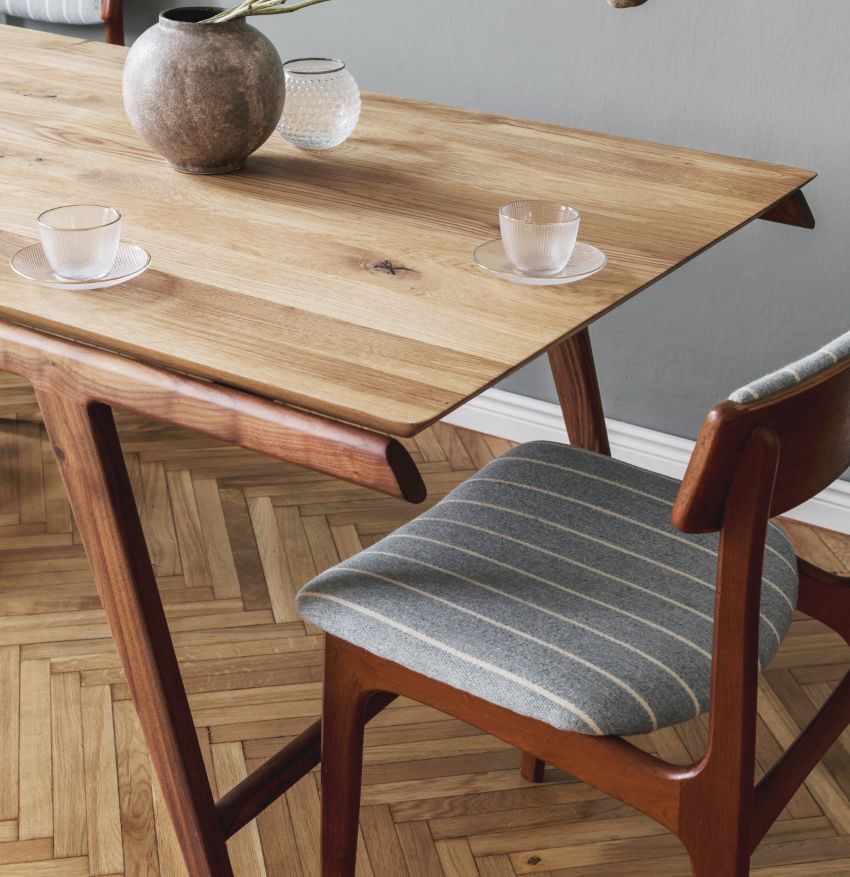
This material is commonly used by carpenters to manufacture inlays and very thin pieces. It is considered a timeless building and furniture wood, and woodworkers love to use it.
Toys and musical instruments can both be made from this material as well. Craftsmen, turners, and sculptors prefer using this kind of wood because it allows them to highlight even the most intricate details.
Maple Wood Furniture Characteristics
Although numerous trees are valued for their heartwood by furniture makers, the sapwood, however, is typically used in beautiful wood furnishing. It has a white tone with a combination of red and brown hues from angular specks and mineral striations, albeit the color will darken over time.
The streaks draw out the mineral streaks more, hence you will see them more frequently and in a darker hue in a stained piece. While its heartwood is brownish-red and occasionally rather dark, it will gradually become softer once it matures.

Almost all hardwoods shift color as they mature. However, exposure to oxygen and UV rays causes light-colored wood to progressively and naturally darken.
Even a piece of white maple will acquire a honey-gold patina over time. As a result, it is usually better to buy furnishing sets all at once rather than collecting them piece by piece as components that are added later will give a somewhat different hue.
Furthermore, it has a smooth, homogeneous texture with mainly straight grain; although patterns such as flame, tiger, curly, bird’s eye, fiddle back, or rippling grain sometimes occur and are frequently used for specialized and handcrafted exquisite furnishing.
Quality Of Furniture Made From Maple
The quality of this furnishing type is extremely durable, eye-catching, and stains perfectly. It is popular among woodworkers and furniture enthusiasts due to its light, creamy hue, seamless grain pattern, and remarkable longevity.
Additionally, a piece of this furnishing absorbs different types of paints and stains efficiently, and its seamless grain makes it an extremely versatile wood selection, which makes it suitable for both casual and elegant styles. Furnishing made from this material can be treated with either light or dark stains, but darker stains work a lot more brilliantly.
However, it may oftentimes have some greenish mineral streaking, which can be seen with a light stain. The streaks offer a unique aspect to a dark stain, with some portions of the wood looking darker than others.
Aside from that, this material is among the most preferred types of wood for refinishing furniture due to its sleek, pure wood grain and homogeneous texture. These characteristics also make it an excellent wood for weathering to get an ancient appearance. Because it is simple to cut and shape, it may be utilized for a variety of furnishing designs.
Maple Color

The color is typically light, resembling pale cream or white. However, the species of this tree and its growth environment might affect the color. Hard Maple, for example, can feature a marginally yellow or reddish color. Other species might be more pallid or grayish in color.
This material has a unique grain pattern, with fine, linear grain that is sometimes characterized as “fluffy,” which can be accentuated or misconstrued by the type of finish applied to the wood.
Is Maple A Hardwood?

Yes, it is, without a doubt, a hardwood. Even so, the hardness of wood is perhaps among the most misinterpreted aspects in general, and this kind of wood just adds to the perplexity.
Hardwood is basically a type of wood that is obtained from a dicot tree including a broadleaf type. A softwood, on the other hand, is produced by a gymnosperm tree like a conifer. It does not refer to the wood’s resistance to pressure, scratches, or fractures.
It is tougher than any other softwood and most hardwoods. However, what makes this material a bit puzzling is that it may be characterized as both hard and soft.
The label “soft” refers to different types of maple trees. The term “hard,” in contrast, pertains to lumber made from the ‘Acer Saccharum species. Nonetheless, because both hard and soft variants are obtained from dicot trees, they are both classified as hardwoods.
Maple Woods Hardness (Janka Rating)

The Janka Test is commonly used to assess the hardness of this wood type. This entails pressing a steel-made ball midway into a piece or block and calculating the amount of power necessary to immerse the ball halfway. The outcome might be shown as pounds of force or as a figure accompanied by the word “Janka.”
The hard variant has a Janka rating of 1,450. It outperforms the majority of other popular wood types among furnishing producers. The soft variant follows a bit close behind, with a Janka rating of 950.
This type of wood is robust and weighty, with high tensile strength. It features a porous structure that is dispersed and has tiny pores. Because the diameter of pores is so tiny, the quantity of fiber components in a unit volume is considerable.

As a result, it has a high density. Once the density of the wood increases, so does its hardness. The consistent texture and linear grain improve both its aesthetic appeal and hardness.
Interestingly, the ring structure and the diffused pores construction with a homogeneous size distribution of pores throughout the entire developing ring are the primary reasons for this material becoming so hard and solid.
Soft maple is also harder than most popular woods, such as chestnut and birch. Therefore, if you are searching for a harder, thicker, and firmer option than the wood type you are presently using for a specific woodwork option or piece of furnishing, this option should be considered.
Hard Vs Soft Maple

Hard maple usually refers to two species: sugar, with the scientific name ‘Acer Saccharum’, and black, with the scientific name Acer Nigrum. It is widely used in floors, furnishing, cabinets, billiard cues, as well as a variety of other finished wooden objects.
Soft maple, on the other hand, normally refers to four species such as red (Acer Rubrum), bigleaf (Acer Macrophyllum, boxelder (Acer Negundo), and silver (Acer Saccharinum).
Various types of furniture, veneers, wooden boxes (crates), railroad crossties, baskets, pallets, railroad ties, and woodenware can all be frequently made from soft maple. The soft flesh of these trees is similar to that of hard maple trees, although it is not equally weighty, hard, or durable.
However, most people are not wood experts. So if you want to identify whether the wood you are dealing with is hard or soft, here are some tips on how you can tell them apart.

Determine the Weight of the Wood
You can weigh an equal part of both wooden pieces or boards to find out which one is heavier. By doing so, you will identify which one is hard or soft.
The heavier of the two would be most probably hard maple. However, even though this method is the simplest way to check if the wood you are working with is either hard or soft types, this is not always 100% precise.
Examine the End Grains of the Wood
The hard variant has a lighter, more consistent color, but the soft type is darker and has grayish, brownish, or reddish streaks. You can observe the gap between the growth rings as well. Because of its long development cycles, hard maple has more closely spaced growth rings.
Examine the Leaves of the Tree From Which the Wood Came
You can try to inspect the leaves to see if the tree from which the wood has been derived. Between the edges of the lead, also referred to as lobes, hard maple leaves usually have U-shaped valleys known as sinuses. The sinuses on soft maple leaves will appear more V-shaped.
Assess the Wood Using Iron Sulfate
Due to the varied chemical characteristics of the wood, a little amount of ferrous sulfate, commonly recognized as iron sulfate, can be applied to the wood. On the hard type, the iron sulfate will acquire a faint blue or green hue, whereas soft variants will acquire a dark blue or black hue.
Maple For Furniture Pros and Cons

This material comes in a variety of species, but regardless of the kind, it makes excellent furniture, flooring, and kitchen items. This is the reason there are a myriad of objects available.
However, just like any other type of wood that is used for making furnishing, this material also has its set of pros and cons.
Pros

Remarkable Hardness and Durability
The hard and soft variants are both strong woods for producing different pieces of furniture. As previously stated, the former has a Janka hardness value of 1,450 lbf while the latter possesses a value of 950 lbf.
Generally speaking, the har variant is much more long-lasting than popular wood types, like red oak, with a hardness rating of 1290 lbf. Furnishing made from this material cannot be quickly dented or damaged due to its increased hardness.
Outstanding Appearance
The beauty of this material is unquestionable. It is available in a variety of warm tones such as neutral beige, shades of red, browns, and chromatic grays, which match nearly all home design color schemes.
If you desire a darker piece, you can dye or stain it. Because these products have very little grain in comparison to other wood species, it offers a smooth and sleek appearance.
Furthermore, the fine grainin includes fewer flaws than other hardwoods, which results in a cleaner and more uniform appearance.
More Affordable and Widely Available
This material is widely available in many countries, making it a more economical selection for making furniture than other hardwood species. There are many different types to pick from, thus you should be able to find one that fits your demands and budget.
You have a number of cost-effective options to pick from if you need a particular piece of furnishing, a dining table, or a maple cabinet.
Very Eco-Friendly
The trees from which this material is sourced from are widespread in certain areas, such as the United States and Canada, and their short growing season allows for harvesting without causing serious damage to the forests. As a result, this is a more sustainable option than slower-growing wood species.
Potentially Aids in Enhancing Indoor Air Quality
This furnishing option is naturally resistant to dust. Hence, it can assist in enhancing indoor air quality by reducing atmospheric pollutants and allergens that are harmful to one’s health.
Cons

Can be Prone to Spills and Scratches
Scratches and stains can be readily noticeable on the smooth surface of these pieces due to their inherently light tone and fewer grains. If you own pets, you must be cautious about this since their claws might produce visible scratches after some time. To maintain its beautiful appearance, you will have to refinish it periodically.
Susceptible to Both Humidity and Heat
This material, like most hardwoods, is vulnerable to significant humidity and temperature fluctuations. If your residence experiences extremely hot summer humidity, this wood may not be good for your furniture since it may expand and shrink, warp or splinter.
Tends to Fade Over Time
Prolonged exposure to sunlight, like with any light-colored hardwood, can make these products appear yellowish with time. If a portion of the surface is subjected to direct sunlight on a daily basis, it will fade faster, culminating in a dual-tone look.
Types Of Maple Used For Furniture

There are multiple types that can be used to manufacture a vast array of pieces. Each type has its particular qualities. Below are some of them:
Solid

Solid maple wood is a very ideal option for making large-surfaced pieces of furnishing such as tabletops, wooden sofas, or cabinets. It is a large piece of wood that has been directly cut from a maple tree. Unlike manufactured wood, which is made out of wood fibers bonded together with resins or glues, this type contains pure wood fibers throughout the hardwood piece.
There are no binders or adhesives utilized and it is easier to fix than veneers or other manufactured woods, which is why it is incorporated into so many different sorts of designs.
Hardrock Maple

Hardrock has a golden brown tone with a delicate light wood grain arrangement that pairs well with solid colors ranging from dark to light. Nonetheless, color variations may occur depending on growth factors and the particular species. It can vary in color from light cream to pale reddish brown.
Hardrock is the alternative name for “hard maple,” a well-known type often used in manufacturing furniture. Hardrock ranks 1450 on the Janka rating of wood hardness, making it among the hardest hardwoods that are commonly used for domestic purposes. It is also recognized for its environmental friendliness and efficiency.
Furthermore, hardrock is known for its significant hardness and density. It also features light-colored wood with fine and straight grain.
Plus, it is commonly used in both modern and traditional furniture styles. Hardrock, however, has always been considered more difficult to deal with due to its extreme hardness, despite its popularity in furniture-making.
Tiger Maple

Tiger maple is a species distinguished by its unusual and rippling grain pattern that mimics tiger markings, hence the name. This type of furnishing is extremely unique and is frequently used only for high-end furniture and ornate craftsmanship. Tiger is also referred to as fiddleback and flame maple.
Furniture made from this material can range in color from pale to medium brown, with a golden or reddish undertone. It features a wavy grain pattern, which can be emphasized with a natural polish or a mild stain.
Tiger is frequently used to build eye-catching furniture pieces like exotic types of dining tables, classic chairs, and artistic kitchen cabinets because of its distinctive and dramatic grain pattern.
Nonetheless, because it is more scarce, it might be more pricey than other species. Additionally, the color, structure, and richness of this material can vary widely depending on the tree and its maturing circumstances. It is tougher than soft maple but not as tough as hardrock.
Birds Eye Maple
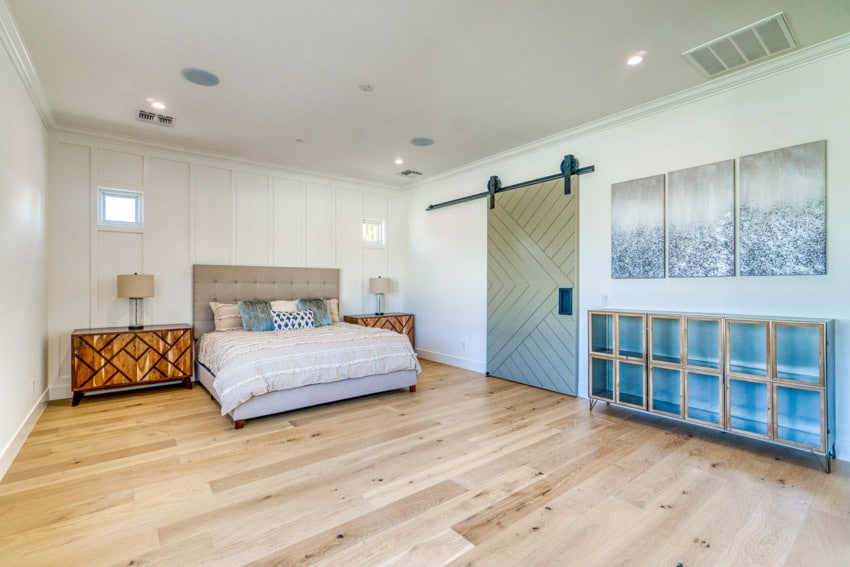
Birds eye is another type that is defined by its small and whirling patterns that are generated by the presence of little knots known as the “bird’s eye”. These knots are created by a genetic flaw in the tree, but they provide the wood with a distinct and appealing aesthetic.
The tree where birds eye comes from strives to develop multiple new sprouts in order to receive more sunlight, but due to poor growing circumstances, the new shoots perish and a few of those little knots remain.
Moreover, this type is also considered somewhat rare and is commonly applied mostly for high-end furniture and artistic handicrafts.
Birds eye is commonly marketed in veneer format, but solid hardwood boards are also available. The bird’s eye pattern is particularly evident and prominent on flat-sawn lumber due to the small knots.
Curly Maple

Curly maple, hence the name, is distinguished by its curly grain arrangement. This rare variety is frequently utilized to create peculiar furniture pieces. The small bending of the fibers that form the wood grain allows the material to bounce light in a distinct way, giving it a three-dimensional appearance.
The gorgeous pattern is especially noticeable once a clear coating or finish has been applied. Furniture manufacturers, woodworkers, and collectors all desire this extraordinary and highly prized type.
In addition, this type of wood can range in color from light to deep brown, occasionally with a red or gold undertone.
This particular type is broadly used to manufacture eye-catching furniture, such as tables, workstations, bookshelves, sideboards, and other items that are supposed to be the center of space due to its exceptional grain pattern.
Wormy Maple
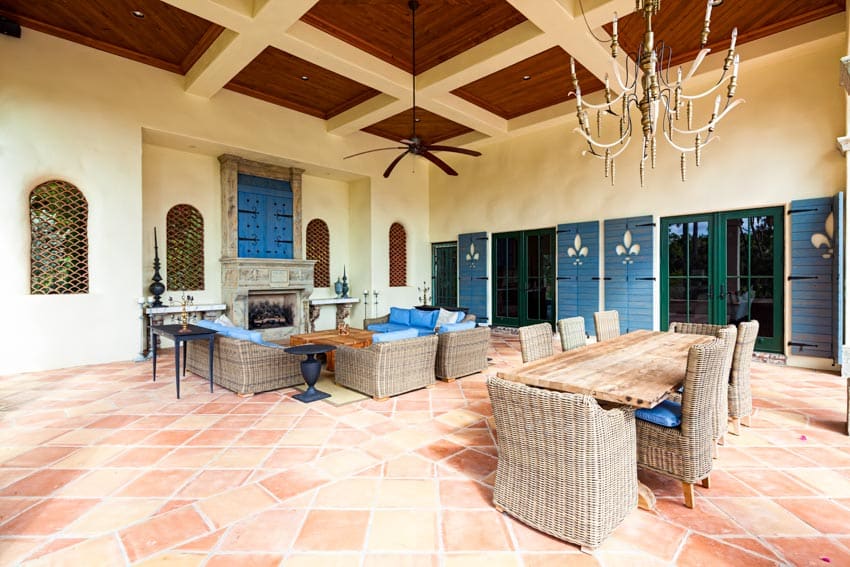
Although it is named the ‘wormy’ maple, the darker markings of this wood are not formed by actual worms. It is a unique sort that has been compromised by the involvement of beetles, which can cause tiny holes and marks in the hardwood surface.
This variety is classified as a rustic wooden furniture option, and it is frequently used for woodwork with a natural and rustic appearance. The color of the wood can range from faint to medium brown, with red or gold undertones.
It is another moniker for maple lumber that has black streaks of discoloration running across it. It is not viewed as defective lumber.
The oblong-shaped color patterns, which resemble wormholes, are still extremely durable. Furthermore, it is widely used to construct rustic or country-style furnishings.
Ambrosia Maple

Ambrosia maple is another type that has been infested with the Ambrosia Beetle fungi, which generates discoloration in the wood. They transport microorganisms into the wood using their feet, which act as nourishment for the larvae when they develop.
The streaks of Ambrosia are normally bluish or greenish and provide a lot of character to the hardwood once completed. This discoloration gives it a peculiar streaking appearance, distinguishing it from other forms. Ambrosia is popular for crafts, specialized wood objects, veneers, and furniture.
The holes that are made by the Ambrosia beetles are not an issue for finished furniture pieces. These beetles are frequently drawn to wood that has begun to dry up. They will not re-infest the wood once it has been kiln-dried.
Aside from that, Ambrosia wood accepts stains and polishes effectively and is generally used to create a variety of furniture themes such as classic, modern, and farmhouse styles.
Spalted Maple
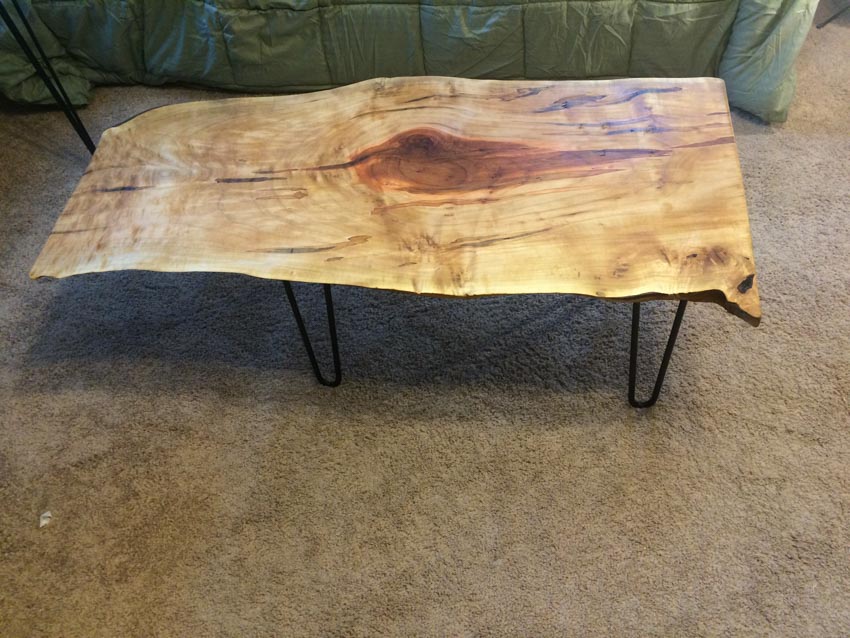
Spalted maple is not actually a particular species, instead, it is a form that has initiated the early phases of decay. Spalting, or incomplete decay, provides the furniture with deep contrasting streaks and lines where the fungi have started to assault the wood.
If the wood was saved from the spalting at the appropriate time, it would be sound and functional, with minimal to zero soft areas or rotten timber. The fungus may produce a wide range of designs, including dark lines, flecks, and whirling formations.
The fungi’s unusual patterns and hues give the spalted type an extraordinary and stunning aesthetic, which makes it a desirable selection for furniture designers and woodworkers searching for a wood that can provide a touch of old-world charm to their projects.

Here are some other popular terms and varieties used for furniture:
• Sugar (Hard Maple). It is the same species that produces the majority of our maple syrup. Plus, it is the most used type for making furniture. However, in hardwood form, it is commonly referred to as hard or rock maple. With a significant Janka hardness rating of 1,450 lbf, it is one of the most robust American native hardwoods.
• Soft. Soft maple refers to a broad group of lumber rather than a single species. It is also used in the manufacturing of many sorts of furniture. The hardness of most soft species is roughly half that of hard maple.
• Silver. Soft maples include silver maple, which grows in the eastern United States and has a wonderful silvery undertone. The silver type is also used to make furniture, although it is much softer than hard maple, with a Janka hardness grade of 750 lbf.
• Bigleaf. Another subtype of soft maple, bigleaf is named after its huge leaves, which are typically six to twelve inches in width. With a Janka hardness grade of 850 lbf, it is slightly a better option for making furniture compared to silver maple.
Since maple is a hard, dense wood with a smooth, even grain, it’s ideal for furniture such as desks, dressers, and kitchen cabinets. – interior designer, Ellen Siloy.
Maple Bedroom Furniture

Maple bedroom furniture relates to furniture pieces constructed from this type of wood and is used in bedrooms. Because of its longevity, durability, and inherent elegance, this material is indeed a common pick for bedroom furniture.
Bedroom furniture made from this material can be found in a range of styles, ranging from classic to modern, and can be treated in a plethora of finishes to complement the overall décor of the bedroom. A bedroom that highlights maple wood normally includes furniture pieces such as:
• Bed frames: This can be the centerpiece of any bedroom and can be obtained in a multitude of designs, including platform beds, four-poster beds, etc.
• Nightstands: Maple types of nightstands are a fantastic choice for the bedroom. They are small-scale tables that are positioned beside a bed and can have a multitude of components like drawers, mini cabinets, shelves, racks, and more.
• Wardrobe: A wardrobe made from this material would be an incredible storage option for a bedroom and is offered in a wide range of shapes, sizes, and styles.
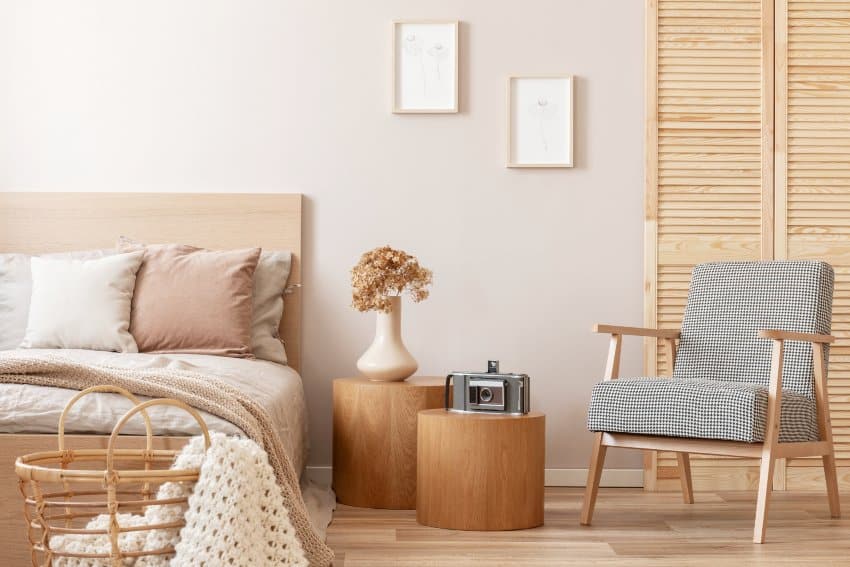
A bedroom consisting of this furnishing types provides an amazing bedroom design that can range from a contemporary to a rustic theme.
Whether you are planning to complete a new bedroom design with a full maple bedroom setup or just want to add an vintage item or two to your current arrangement, combining old and new furniture pieces may offer a lot of aesthetic value.
Compared to honey maple color, light maple furniture cabinets are less tricky when it comes to matching colors to your wood since its mid-tone orange color is less prominent. – interior designer, Ellen Siloy
Maple Dining Room Furniture
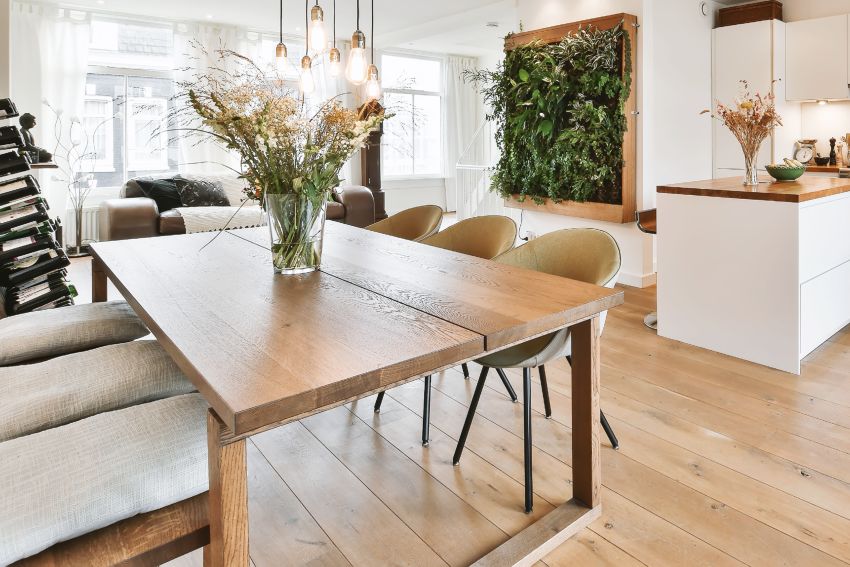
Dining room furniture constructed of genuine maple wood is guaranteed to last and is intended to be handed from one generation to the next. This material is known for its incredible hardness, and furniture pieces constructed from it ensures that your dining room tables or chairs do not wobble.
Maple Tables

Tables made from this material can be useful for a plethora of functions, including dining tables, outdoor tables, coffee tables, bedside tables, and desks. They can be treated with a wide range of stains and varnishes to accentuate their inherent beauty and safeguard the wood from damage.
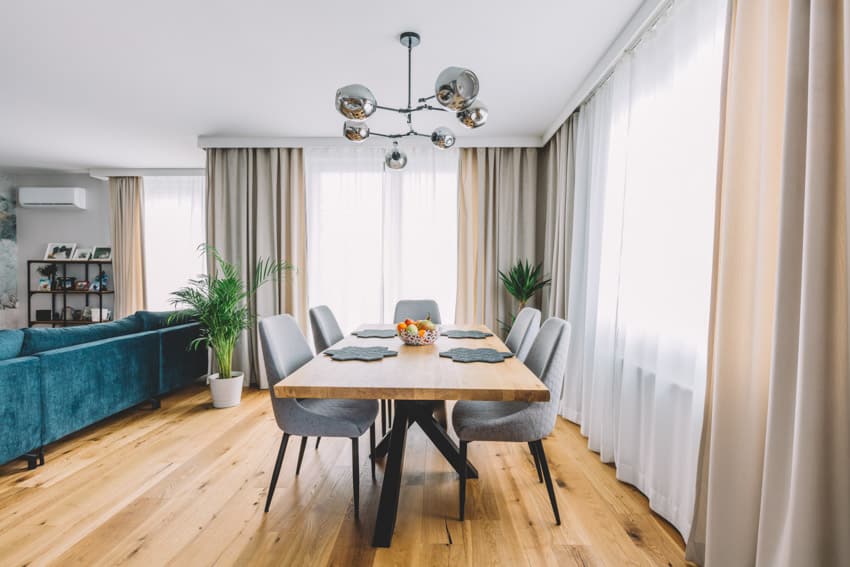
Tables constructed from this type of wood can also be personalized to a particular room or design aesthetic. And since they are highly durable, they can withstand the abuse that standard tables would normally face.
Maple Chairs

Dining chairs made from this material are primarily intended for usage in a maple-themed dining room. These ultra-durable dining chairs are usually created with a vintage or antique appearance, and they can be coated with a range of stains and varnishes to emphasize their natural beauty and preserve the wood from different harmful elements.
Furthermore, these dining chairs are well-known for their durability, luxury, and exquisite appearance, making them a wonderful selection for any dining room or kitchen environment. They can also be combined with complementary dining tables to create a unified aesthetic.
Maple Office Furniture

Office furniture made from this material is composed of wooden pieces that are designed to be used in an office environment. Most office furniture pieces can be stylish and formal-looking. The following are some of the furniture pieces that are commonly found in a maple-themed office:
• Desks: These are available in a variety of dimensions, designs, and patterns. These desks can be antique or modern and can include functionalities including drawers, display cases, keyboard trays, printer holders, and more.

• Bookshelves: Bookshelves made out of this material can last for decades. They may also include extra useful features including adjustable shelves, glass sliding doors, and others.
• Filing Cabinets: Since this material is very durable, it can also work as a safe storage for your important files.
Best Stain For Maple Furniture

When staining a particular piece of furniture, it would be essential to pick a stain that will both highlight the natural beauty of the wood and provide the utmost protection.
Generally speaking, a penetrating oil-based stain is considered one of the finest types of stain for protecting and beautifying these pieces. These stains permeate deeply into the wood grains, offering long-lasting coverage as well as a natural appearance.
They also draw out the underlying gorgeous grain patterns and colors of the material. Oil-based stains will indeed provide it with a rich-looking hue that will look naturally beautiful for an extended period.
Interestingly, oil-based stains are simple to use and can be effortlessly brushed or wiped onto the wood surface. They also dry gradually, giving you plenty of time to incorporate the stain into the wood and get a smooth and uniform finish.
Oil-based stains are also highly resistant to wear and tear, which renders them an ideal stain option.
Furthermore, oil-based stains are arguably more water-resistant than water-based stains, making them suitable for application on these products that will get constantly spilled or wet.
However, it is important to note that before staining, you should first try the oil-based stain on a tiny and unnoticeable part of the wood to determine if it is the right stain that matches your needs and preferences.
Maple Vs Oak Furniture
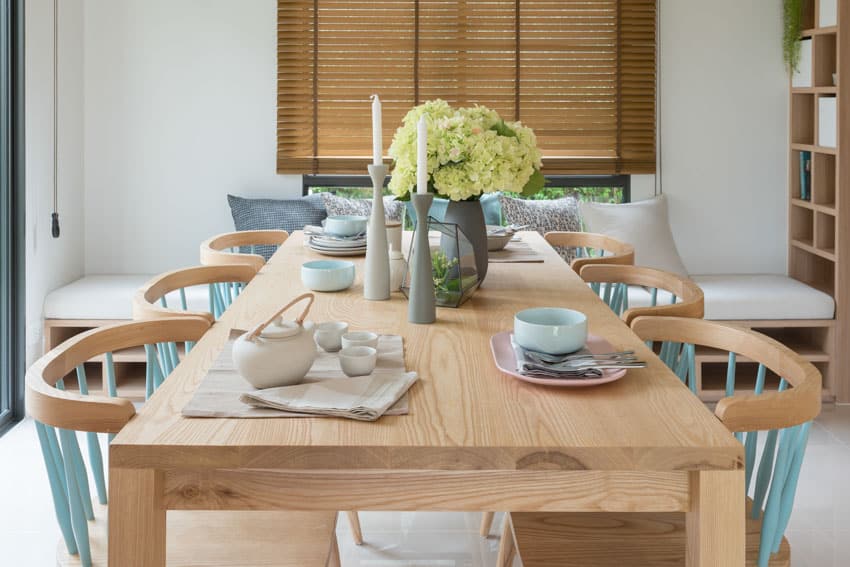
Color: Oak has a reddish hue and ranges from light yellow to medium brown. Maple can range in hue from creamy white to reddish-brown.
Appearance: Maple has a finer, more polished appearance with a finer, more consistent grain pattern than oak. It can also have complex patterns like curly or bird’s eye, making it more adaptable and appropriate for a wide range of furniture. Oak, meanwhile, has a recognizable open-grain pattern with vast, visible pores that give it a rustic appearance.
Stability and Hardness: Maple is generally more stable than oak, which means it will bend and crack less throughout time. Hence, it is a preferable choice for furniture that may be subjected to temperature fluctuations.
Its Janka rating (1450 lbf) is also higher than oak (1290 lbf). Oak is thought to be more rot- and decay-resistant. However, the latter is more impervious to scratches and dings.
Workability: Because of its density and hardness, oak is more challenging to work. It is simpler to work with and less likely to split or fracture.
Cost: This material is often less expensive than oak, making it a more cost-effective choice for making furniture.
Maintenance: Both materials are long-lasting hardwoods that require minimal maintenance. Both of these merely require routine cleaning and staining or sealing to maintain their beauty.
Popularity: Because of its widespread availability, oak is widely believed to be more popular. Oak is a popular wood for antique and rustic furniture because of its incredible durability and longevity.
Maple, nevertheless, is recognized for its light hue and smooth texture and is frequently used in modern and contemporary furniture designs.
It is a genuine and artistic type of, and it is not just any average wood. Each piece of this hardwood has a distinct grain pattern, making every furniture item unique. Its naturalistic color adds warmth and serenity to any space, making it an adaptable solution for any home décor.
Indeed, this type of wood is commonly used in the production of high-end furniture, floors, cabinets, and other kitchen products. These furniture is designed to survive for decades, which makes it an antique treasure that could be passed down through generations due to its durability and solidity.
For more related content, see our maple kitchen cabinets design ideas.






